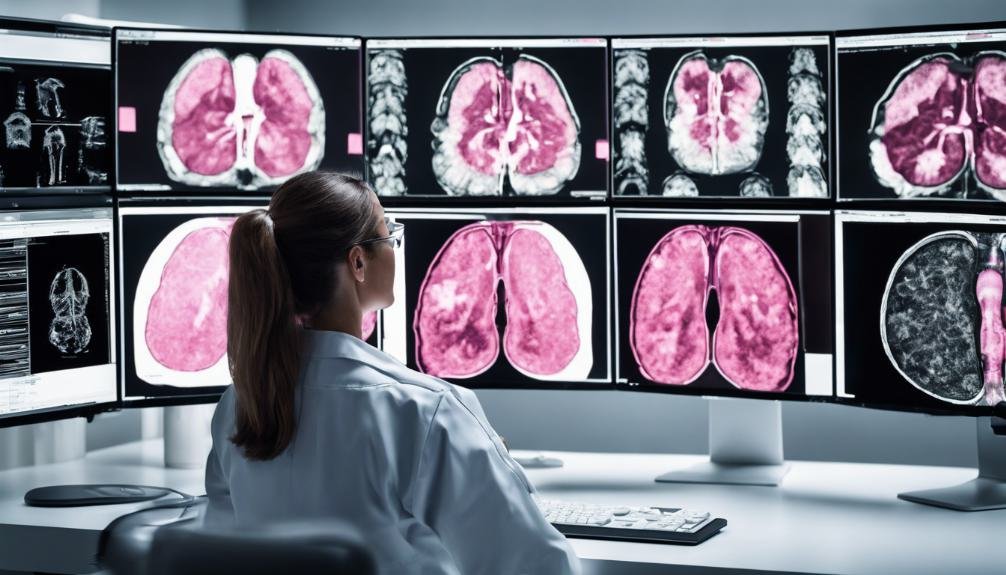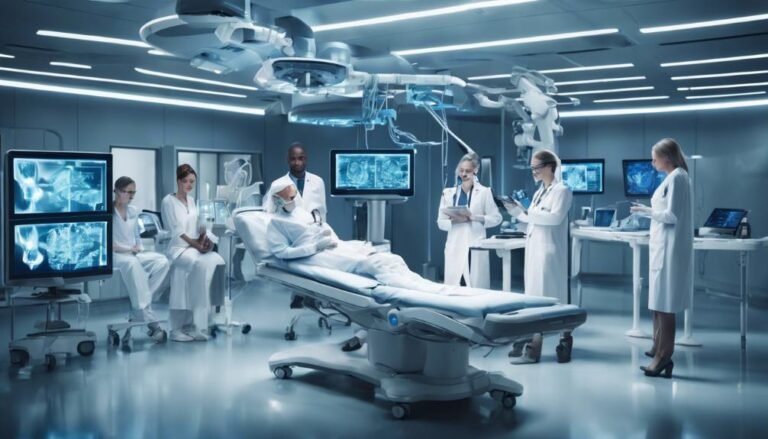AI for Mammography
In the domain of mammography, AI stands as a beacon of progress, reshaping the landscape of breast cancer detection. As you navigate through the intricacies of AI integration in mammography, you'll uncover a realm where technology intertwines with human expertise to redefine diagnostic precision. However, the true power of AI in this field lies not only in its ability to enhance radiologists' capabilities but also in its potential to revolutionize patient care. Stay tuned to explore the transformative journey that AI is embarking upon in the domain of mammography.
Key Takeaways
- AI enhances accuracy and efficiency in mammography screening.
- AI reduces false positives and negatives, improving diagnostic reliability.
- AI expedites detection process, aiding in early cancer identification.
- AI assists radiologists in detecting subtle signs for timely intervention.
- AI innovations revolutionize breast cancer detection and personalized treatment.
The Impact of AI in Mammography
AI has revolutionized mammography by enhancing the accuracy and efficiency of breast cancer detection through advanced image analysis techniques. The integration of AI in mammography has greatly impacted patient care by improving the overall quality of screenings.
Mammography has evolved drastically over the years, with technology advancements paving the way for more precise and reliable results.
AI integration in mammography has allowed for better detection of abnormalities, leading to earlier diagnosis and treatment of breast cancer. By analyzing mammographic images with high accuracy, AI systems can assist radiologists in detecting subtle signs of cancer that may be overlooked in traditional screenings. This improved level of detection not only enhances patient outcomes but also reduces the need for unnecessary follow-up tests, minimizing patient anxiety and discomfort.
Furthermore, the use of AI in mammography streamlines the interpretation process, enabling radiologists to focus more on complex cases while AI algorithms handle routine screenings efficiently. This division of labor enhances workflow productivity, ultimately benefiting both healthcare providers and patients.
Advantages of AI in Breast Cancer Detection
AI technology offers enhanced accuracy in diagnosing breast cancer by analyzing mammograms with high precision, leading to fewer false positives and false negatives.
Additionally, AI algorithms can expedite the detection process, enabling healthcare professionals to identify potential cases promptly and initiate treatment swiftly, ultimately improving patient outcomes.
The integration of AI in mammography not only enhances the efficiency of the diagnostic workflow but also assists in reducing the burden on radiologists, making breast cancer detection more effective and reliable.
Enhanced Accuracy in Diagnosis
By utilizing advanced algorithms, AI systems have greatly enhanced the accuracy of detecting and diagnosing breast cancer in mammography screenings. AI algorithms, through machine learning techniques, are capable of analyzing mammograms with a level of precision that surpasses traditional methods. These algorithms can identify subtle patterns and anomalies in the images that might be missed by the human eye, leading to improved diagnostic enhancements.
The integration of AI into clinical practice has shown promising results in increasing the sensitivity and specificity of breast cancer detection. Studies have demonstrated that AI systems can reduce false positives and false negatives, thereby providing more reliable results for healthcare professionals. By assisting radiologists in interpreting mammograms, AI contributes to a more accurate and timely diagnosis, ultimately improving patient outcomes.
Furthermore, AI technologies have the potential to standardize interpretations across different facilities, ensuring consistent and high-quality assessments regardless of the interpreting physician's experience level. The continuous advancement of AI in mammography holds great promise for further enhancing the accuracy and efficiency of breast cancer diagnosis.
Faster Detection Process
How does the integration of advanced algorithms into mammography screenings revolutionize the speed of breast cancer detection processes?
AI driven workflow optimization plays an essential role in expediting the detection process. By automating tasks such as image analysis, patient data management, and result reporting, AI streamlines the workflow, reducing the time between screening and diagnosis considerably.
Moreover, AI assisted image interpretation enhances the speed at which mammograms are analyzed. These algorithms can quickly pinpoint areas of concern, flagging suspicious findings for radiologists to review promptly. This not only accelerates the interpretation process but also guarantees that potential abnormalities are identified and addressed swiftly.
The combination of AI driven workflow optimization and AI assisted image interpretation leads to a more efficient and rapid breast cancer detection process. By leveraging the power of artificial intelligence, healthcare providers can expedite screenings, reduce turnaround times for results, and ultimately enhance patient outcomes.
Enhancing Radiologists' Accuracy With AI
AI plays a vital role in improving diagnostic accuracy in mammography by assisting radiologists in detecting subtle abnormalities. The collaboration between radiologists and AI systems has shown benefits such as reduced missed diagnoses and improved overall interpretation accuracy.
AI Improving Diagnostic Accuracy
Utilizing artificial intelligence in mammography has shown promising results in enhancing the diagnostic accuracy of radiologists through advanced image analysis techniques.
Machine learning algorithms, particularly deep learning models, have been pivotal in improving image interpretation by detecting subtle patterns and anomalies that may not be easily discernible to the human eye.
These AI systems are integrated into the clinical workflow, assisting radiologists in making more accurate and timely diagnoses.
Radiologist-Ai Collaboration Benefits
Collaborating with artificial intelligence systems greatly enhances radiologists' diagnostic accuracy by leveraging advanced image analysis capabilities to detect subtle patterns and anomalies. Through radiologist training, AI collaboration optimizes workflow by assisting in the interpretation of mammograms, leading to more efficient and accurate diagnoses. By integrating AI into their practice, radiologists can benefit from improved detection rates, reduced false positives, and enhanced overall performance.
AI collaboration offers radiologists the opportunity to fine-tune their skills by providing real-time feedback and aiding in the identification of areas that may require further evaluation. This synergy between human expertise and machine learning algorithms not only increases accuracy but also fosters continuous learning and development within the field of radiology.
Furthermore, the integration of AI systems into radiology practices can streamline processes, reduce interpretation times, and ultimately improve patient outcomes. By embracing AI technology, radiologists can enhance their diagnostic capabilities, ultimately providing better care for individuals undergoing mammographic screenings.
AI-Powered Early Abnormality Detection
Early abnormality detection through the integration of advanced algorithms has shown promising results in improving mammography accuracy.
AI-driven screening for breast cancer using machine learning algorithms has greatly enhanced early detection capabilities. These algorithms are designed to analyze mammograms, identifying subtle abnormalities that may be indicative of early-stage cancer.
By utilizing sophisticated abnormality recognition techniques, AI can assist radiologists in flagging areas of concern that might be overlooked during manual interpretation.
The ability of AI to process vast amounts of data quickly and accurately increases the likelihood of detecting potential abnormalities at an early stage, leading to timely intervention and improved patient outcomes.
Machine learning algorithms can learn from vast datasets, continuously improving their ability to detect abnormalities with high sensitivity and specificity. This technology aids in reducing false positives and false negatives, thereby enhancing the overall efficiency of mammography screening programs.
The integration of AI-powered early abnormality detection into clinical practice holds great promise for revolutionizing breast cancer screening and diagnosis.
Improved Patient Outcomes With AI
AI-driven early abnormality detection in mammography has shown significant potential in improving patient outcomes by enhancing the accuracy and efficiency of breast cancer screening programs.
By integrating AI into mammography, healthcare providers can offer improved patient satisfaction through more precise and timely diagnoses. AI algorithms can assist radiologists in detecting subtle abnormalities that might be overlooked, leading to earlier detection of breast cancer and ultimately better outcomes for patients.
Moreover, AI integration in mammography can streamline workflows, reducing wait times for results and follow-up appointments. This not only increases healthcare efficiency but also guarantees that patients receive timely care, contributing to improved outcomes.
Patient satisfaction is also enhanced as AI helps in minimizing unnecessary biopsies and false-positive results, reducing patient anxiety and improving overall experience. The combination of AI technology with mammography holds the promise of transforming breast cancer screening programs, ultimately leading to better patient outcomes and higher quality of care.
AI's Role in Early Intervention
Utilizing advanced algorithms, artificial intelligence (AI) plays a pivotal role in enhancing early detection and intervention strategies for breast cancer through mammography. AI's role in prevention and early intervention is vital in improving patient outcomes. Mammography AI technology advancements have enabled more accurate and timely identification of breast abnormalities, allowing for proactive measures to be taken at an earlier stage.
AI algorithms can analyze mammograms with a high level of precision, detecting subtle patterns and anomalies that might be overlooked by human radiologists. This capability leads to earlier identification of potential cancerous lesions, increasing the chances of successful treatment and improving overall survival rates.
Moreover, AI assists in risk assessment by analyzing various factors such as breast density, genetics, and previous imaging results to determine individualized screening protocols. By providing tailored recommendations for follow-up screenings or preventive measures, AI contributes significantly to the early intervention efforts in combating breast cancer.
The integration of AI in mammography not only enhances diagnostic accuracy but also empowers healthcare providers to deliver more personalized and effective care to patients.
Harnessing AI for Better Breast Cancer Treatment
Cutting-edge advancements in artificial intelligence technology are transforming the landscape of breast cancer treatment, offering unprecedented opportunities for enhancing patient outcomes and personalized care. AI is playing a pivotal role in treatment optimization by analyzing vast amounts of data to assist healthcare providers in making more informed decisions.
Through AI assistance, treatment plans can be tailored to individual patients based on their specific characteristics, such as genetic makeup, tumor characteristics, and treatment responses.
Personalized care is being greatly enhanced through the integration of AI in breast cancer treatment. AI algorithms can analyze a patient's medical history, imaging results, and other relevant data to recommend personalized treatment options that are more effective and have fewer side effects. This integration allows for a more targeted approach to treatment, improving patient satisfaction and overall outcomes.
Future of Mammography: AI Innovations
Moving forward, the advancements in mammography are increasingly shaped by innovative AI technologies that are revolutionizing the detection and diagnosis of breast abnormalities. AI advancements in mammography are paving the way for more accurate and efficient screenings.
These technologies can analyze mammograms with a high level of precision, aiding radiologists in detecting subtle signs of breast cancer that might be overlooked by the human eye.
The future applications of AI in mammography include the development of algorithms that can predict the risk of breast cancer based on imaging data and patient history. Additionally, AI systems are being designed to assist in personalized treatment planning by analyzing imaging results and suggesting tailored treatment options.
As these AI innovations continue to evolve, they hold the promise of enhancing the early detection and management of breast cancer, ultimately improving patient outcomes and reducing healthcare costs.
Conclusion
You can trust AI for mammography to revolutionize breast cancer detection. Its advanced algorithms and image analysis techniques greatly enhance accuracy and efficiency, leading to earlier diagnosis and treatment.
With AI, radiologists' accuracy is improved, abnormality detection is expedited, and patient outcomes are optimized.
The future of mammography is bright with AI innovations, making it an essential tool in the fight against breast cancer.
The impact of AI in this field is truly groundbreaking.







